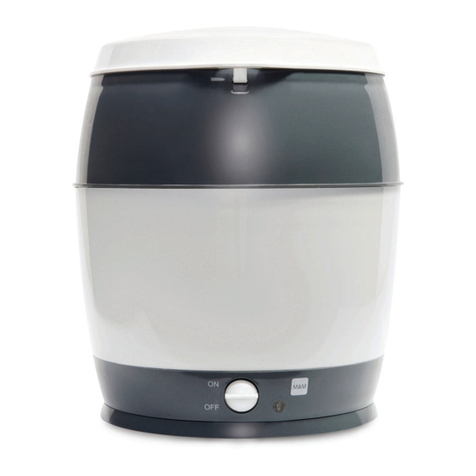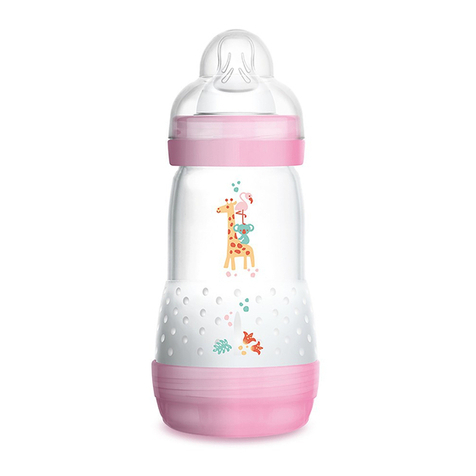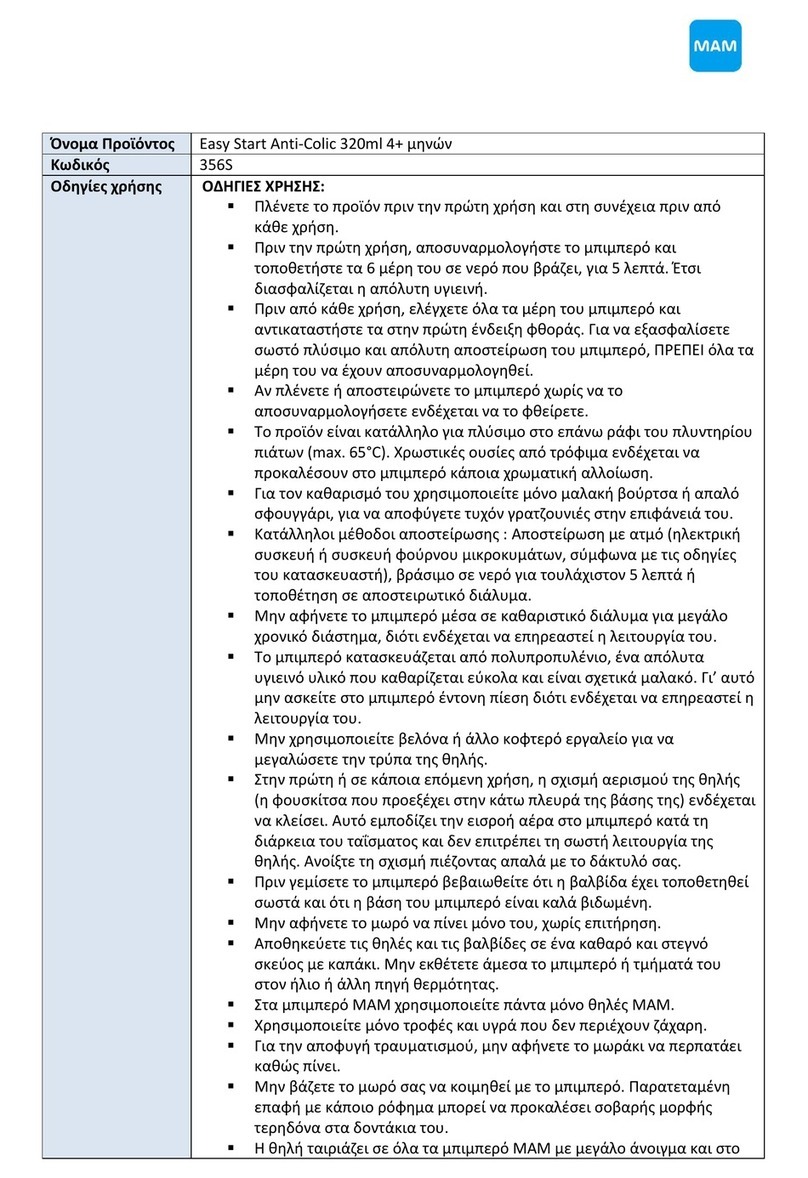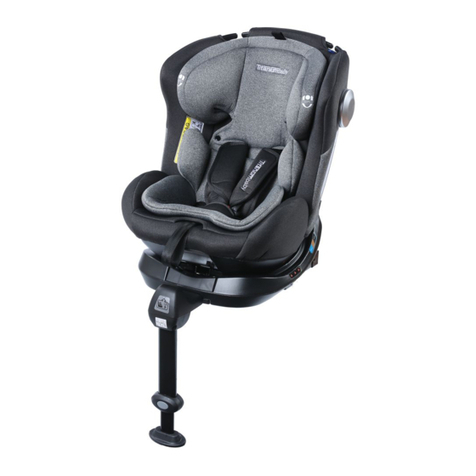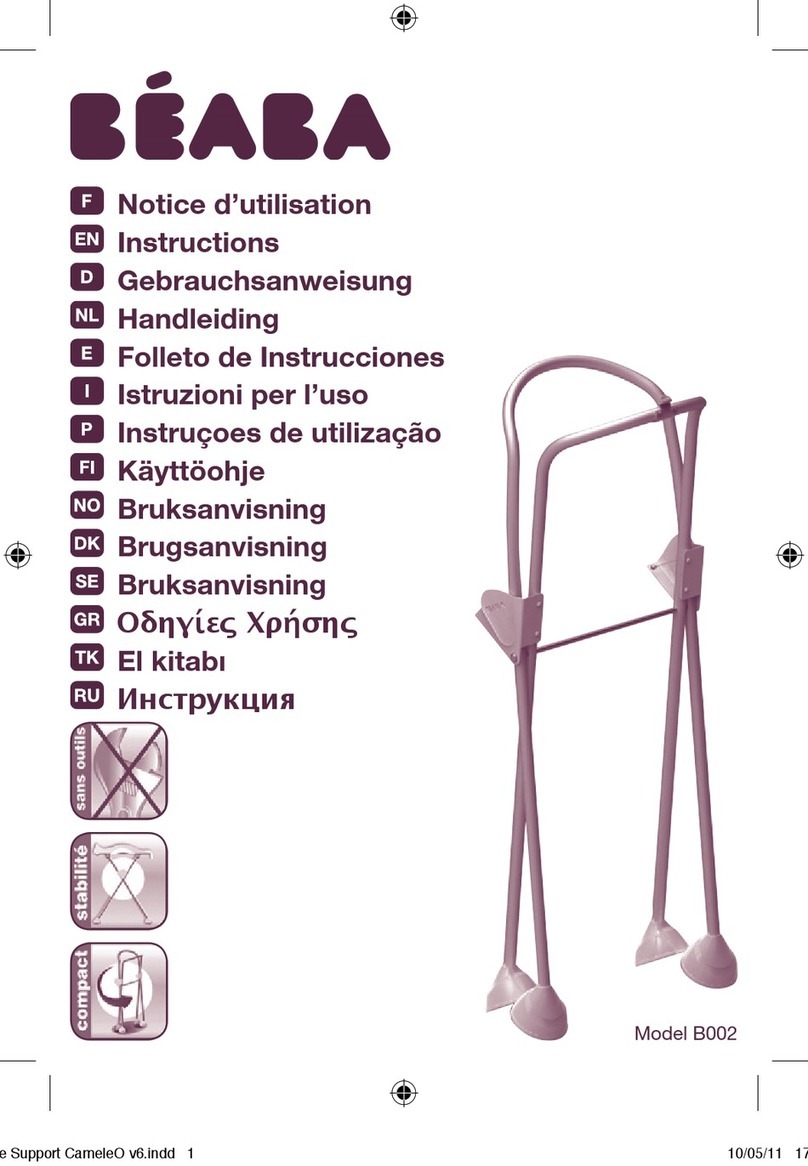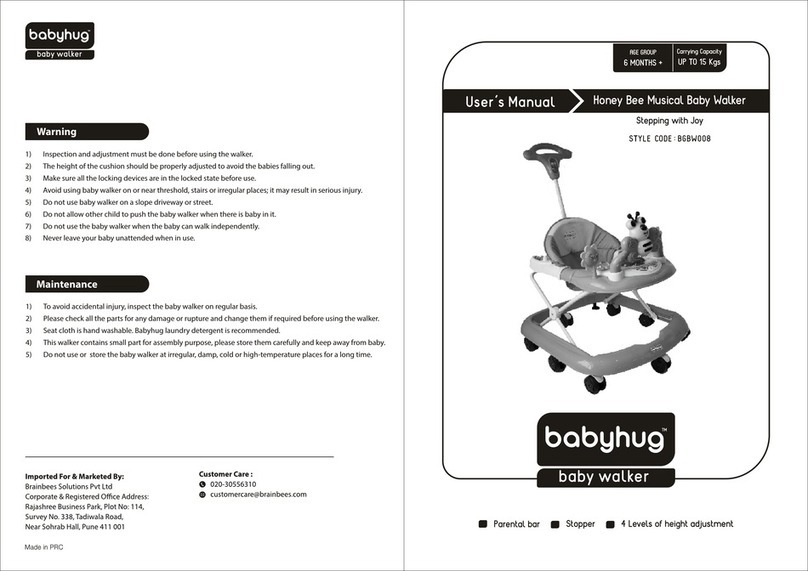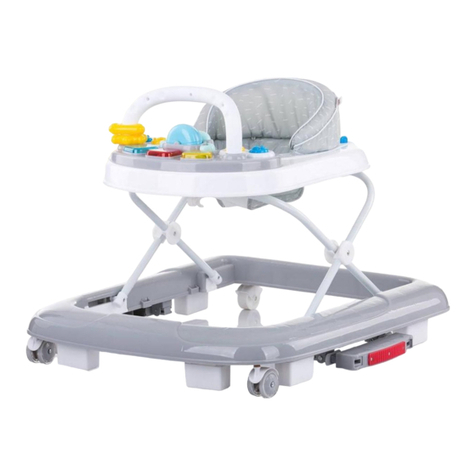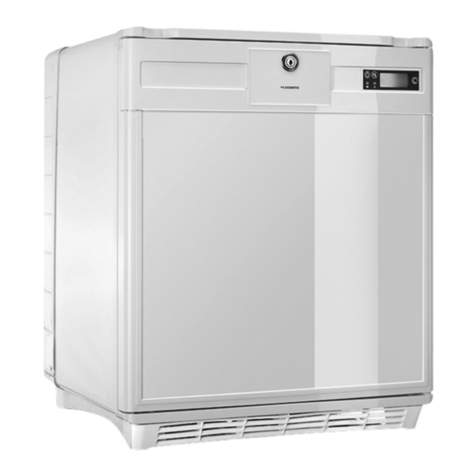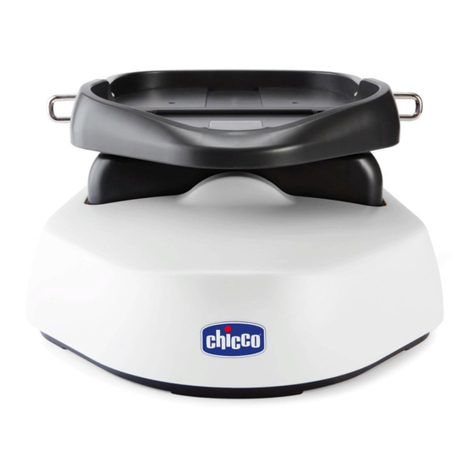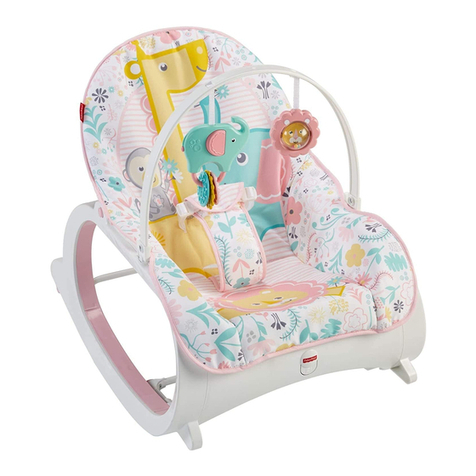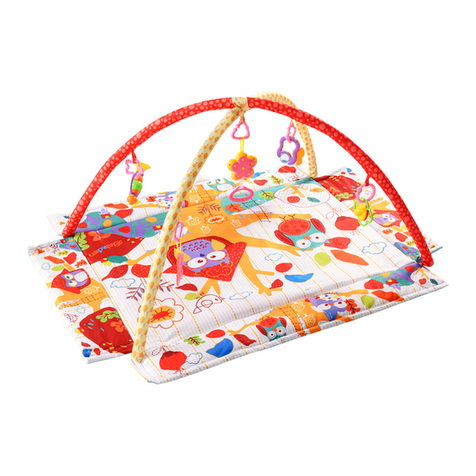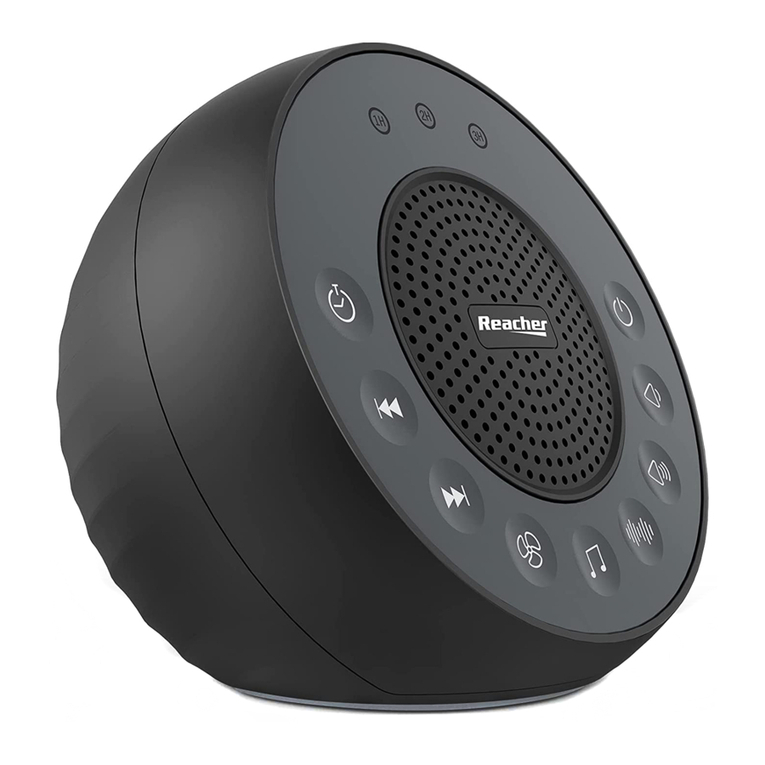MAM Easy Start Anti-Colic User manual

Online Shop
Electrical Products
English

2
Content
Electric Steriliser & Express Bottle Warmer
1. General sterilising instructions ............................................ 3
1.1. Using the Electric Steriliser ................................................... 4
1.2. Using the Microwave Steriliser ............................................ 4
2. Bottle & Food Warmer instruction ........................................ 5
3. Cleaning and maintaining the appliance ........................... 7
4. Environment/Disposal .......................................................... 7
5. Warranty .................................................................................8
6. Repair notes ........................................................................... 8
7. Technical data ........................................................................8
8. Safety notes ............................................................................8
9. MAM Easy Start™ Anti-Colic................................................10
10. MAM Start ............................................................................. 11
2in1 Single Breast Pump
1. Product description ............................................................. 12
2. Safety notes .......................................................................... 12
3. Cleaning and maintaining the appliance ......................... 15
4. Using the appliance ............................................................ 16
4.1. Electric pumping .................................................................. 16
4.2. Manual pumping ................................................................ 17
4.3. Use in combination with the MAM Storage Solution ....... 19
5. Storing and warming breast milk ...................................... 19
6. Feeding ................................................................................ 20
6.1. MAM Easy Start™ Anti-Colic bottle .................................. 20
7. Troubleshooting for breast pump ..................................... 22
8. Environment/Disposal ....................................................... 23
9. Warranty .............................................................................. 23
10. Repair notes ........................................................................ 23
11. Technical data.......................................................................23
2in1 Double Breast Pump
1. Product description ............................................................ 24
2. Safety notes ......................................................................... 24
3. Cleaning and maintaining the appliance ........................ 27
4. Using the appliance ........................................................... 28
4.1. Electric pumping ................................................................. 28
4.2. Manual pumping ............................................................... 30
4.3. Use in combination with the MAM Storage Solution ....... 31
5. Storing and warming breast milk ...................................... 31
6. Feeding ................................................................................ 32
6.1. MAM Easy Start™ Anti-Colic bottle .................................. 32
7. Troubleshooting ...................................................................35
8. Disposal .............................................................................. 35
9. Warranty .............................................................................. 36
10. Repair notes ........................................................................ 36
11. Technical data ..................................................................... 36

3
Electric Steriliser & Express Bottle Warmer
Please read all instructions carefully before using the MAM Electric Steriliser & Express Bottle Warmer for
the first time. Keep these instructions for future reference. MAM Electric Steriliser & Express Bottle Warmer
allows you to warm, defrost and sterilise all MAM and common Bottles and Milk Storages, as well as
baby food safely and quickly.
Suitable for sterilising bottles, soothers and
cup components. Before putting the items in
the Steriliser, carefully wash all items (soothers,
bottles etc.) in mild soapy water and rinse with
clean water. Arrange the parts into the bas-
kets evenly by ensuring that the steam flow is
not blocked. Do not use the device for metal or
electronic parts. Always use the correct quan-
tity of water. Using too much or too little water
can result in incomplete sterilising function
and can damage the device and the micro-
wave. TAKE CARE when handling recently dis-
infected items as they may still be hot. Wash
your hands before touching disinfected items.
CAUTION! Only place items in the Steriliser
that are suitable for sterilising. Do not disinfect
items that are filled with liquid: e.g. a teether
containing cooling fluid.
SCALDING HAZARD: When opening the Ster-
iliser after use, hot water vapour can escape
and the remaining water may be very hot. Use
sterilised tongs to remove and assemble the
parts. Sterilised products kept in unopened Steriliser stay disinfected for up to 48 hours. To achieve the best
possible sterilising and warming eciency, do not operate other powerful electrical items at the same time
on the same socket or circuit.
1. General sterilising instructions
Assembling of the Electric & Microwave Steriliser
Steriliser Lid
Steriliser
Upper
Basket
Steriliser
Lower
Basket
Electric Sterilising
Microwave Sterilising
Steriliser Bowl
Latches
Steriliser Valve
Base Cover
Base
Sealing Ring
Tongs
Interface display guide
Defrosting & Food Warm-
ing Programme
Selection & Start
Programme
Express Warming
Programme
Gentle Warming
Programme
Sterilising
Programme
ON/OFF
Programme
Easy
Start
130 ml
Easy
Start
160 ml
Easy
Start
260 ml
Easy
Start
320 ml
Trainer+
220 ml
Easy
Active
270 ml
Easy
Active
330 ml
Feel
Good
160 ml
Feel
Good
260 ml
number of bottles 6 6 4 4 6 6 5 4 4
number of pacifiers 3 3 3 3 3 3 3 3 3
In order to achieve a sucient disinfection eect up to 24h, the number of products sterilised to-
gether must not exceed the maximum numbers mentioned below:

4
1.1. Using the Electric Steriliser
1.) Correct assembly of the Electric Steriliser is illustrated at the beginning of Section 1.
2.) Check that the sealing ring is pressed down firmly in its place, this never needs to be removed.
3.) Pour 200ml/7 fl oz tap water directly into the Base (Fig. 1).
4.) Fix the Steriliser Base Cover onto the Base using the grooves to “fit and twist” the cover (Fig. 2).
5.) Place the disassembled bottle and components in the upper and lower Baskets of the Steriliser.
6.) Close the Steriliser. The Steriliser Lid must “click“ into place.
7.) Place the Steriliser on the Base Cover (Fig. 3).
8.) Insert the plug into the wall socket. Place it on a flat, stable surface.
9.) Switch the device ON (Fig. 4). The light on the sterilising programme will appear, along with a short
beep.
10.) Press the programme selection button for 2 seconds to start the sterilising programme (Fig. 8). A long
beep is heard and the light flashes constantly while the programme is running.
11.) The programme will run for 7 minutes and will automatically stop afterwards with 3 long beeps. Light
stops flashing.
12.)Cooling down period starts: all 4 LEDs are lit. Allow the Steriliser to cool before removing the lid. Cooling
period will automatically stop after 4 minutes along with 3 long beeps.
13.)Press OFF to turn the device o. Pour out any remaining water from the Base and dry with a soft cloth.
The programme can be interrupted by pressing the programme selection button . If programme is
interrupted – please restart the entire process.
1.2. Using the Microwave Steriliser
1.) Correct assembly of the Microwave Steriliser is illustrated at the beginning of Section 1.
2.) Open the latch on the Microwave Steriliser and remove the Steriliser Lid.
3.) Remove the Steriliser Upper and Lower Baskets as necessary.
4.) Close the blue Steriliser Valve on the bottom of the Steriliser Bowl.
5.) Pour 200 ml tap water into the Steriliser Bowl. Place the disassembled bottles and components in the
upper and lower Baskets of the Steriliser.
6.) Close the Steriliser. The Steriliser Lid must “click“ into place. Place the Steriliser in the microwave.
7.) The Steriliser works with all commercially available microwave devices. There must be some space
between the microwave and Steriliser. Using a microwave that is too small can damage the steriliser
Fig. 1 Fig. 2
Fig. 3
Fig. 4
Easy
Start
130 ml
Easy
Start
160 ml
Easy
Start
260 ml
Easy
Start
320 ml
Trainer+
220 ml
Easy
Active
270 ml
Easy
Active
330 ml
Feel
Good
160 ml
Feel
Good
260 ml
number of bottles 4 4 3 3 6 5 4 3 3
number of pacifiers 7 5 10 8 5 5 10 5 5
To achieve a disinfection eect up to 48h, the maximum number of products sterilised together shall
not exceed:

5
and the microwave. Never place in the microwave without water. Do not use bleach. If using a
combination microwave oven, ensure that the Microwave Steriliser is not exposed to the heat of the
grill because this could damage steriliser, products and microwave.
8.) Sterilising times correspond to the microwave’s wattage
(Fig. 5).
9.) Allow the Steriliser to cool before removing from the
microwave. Recommended cooling time: minimum of 3
minutes with the microwave door open.
10.)For immediate use of the products any leftover water in the
products can be removed by using the draining function in the lid. There are drainage grooves on the
inside of the Steriliser Lid.
11.) Items can be placed inside the upturned Steriliser Lid individually or with in the Steriliser Baskets.
2. Bottle & Food Warmer instruction
Assembling the Bottle & Food Warmer
1.) Correct assembly of the Bottle & Food Warmer is illustrated at the beginning of Section 2.
2.) Use the Bottle & Food Warmer chart (Fig. 10) or the Gentle Warming Chart (Fig. 11) to determine how
much water you need. Pour the correct quantity of water into the base (Fig. 6). You can use the MAM
Bottle Cap as a measure.
Bottle & Food Warmer Chart (Fig. 10)
Please note: This chart provides you with approximate values for warming liquid & food. The time required
for the food to reach the right temperature varies according to the container you are using, how much food
you are warming and the temperature of the food before warming. Make sure you use the correct quantity
of water. With a little practice, you will quickly learn which settings will give you the ideal food temperature.
The programme automatically stops at the end of the heating cycle.
Bottle
Warmer
Cover
Bottle
Warmer
Basket
Base
Sealing Ring
Fig. 6 Fig. 7
Fig. 8 Fig. 9
Power Time Cooling time
650 – 1000 W: 11 min 3 min
1050 – 1800 W: 6 min 3 min
1850 W: 5 min 3 min
Fig. 5

6
Gentle Warming Chart (Fig.11) Please note: This chart provides you with approximate values for warming
breast milk. The time required for the breast milk to reach the right temperature varies according to how much
breast milk you are warming and the temperature of the breast milk before warming. Make sure you use
the correct quantity of water and the Easy Start Bottle. With a little practice, you will quickly learn which settings
will give you the ideal temperature. The gentle warming process helps to preserve nutrients and maintain
the optimal integrity of breast milk. For handling volumes below 140 ml the programme has to be stopped
manually. If you want to warm 150 ml or more, the programme will stop automatically after one hour. Always
check the temperature of the milk before feeding your baby.
3.) Place the Bottle Warmer Basket and Bottle Warmer Cover on the Base.
4.) Remove the teat/cover/lid from the bottle, container, then place the container in the Bottle Warmer
Basket (Note: To avoid damaging bottles or containers, always use the Bottle Warmer Basket and Cover
for bottle & food warming). Insert the plug into the wall socket.
5.) Press ON to switch on the device (Fig. 7). The light on the sterilising programme will appear, along with
a short beep.
Programme Container Volume Initial temperature Water quantity approx. app. Time
Express
Warming
Plastic
Bottle
130ml
Room temperature 35ml
Minimum of
2.30 min.
Refrigerator temperature 45ml
160ml
Room temperature 35ml
Refrigerator temperature 45ml
260ml
Room temperature 45ml
Refrigerator temperature 75ml
Glass
Bottle
170ml
Room temperature 15ml
Minimum of
1.50 min.
Refrigerator temperature 20ml
260ml
Room temperature 15ml
Refrigerator temperature 20ml
Defrosting and
Food Warming
Milk
Storage
60ml Freezer temperature 50ml
Minimum of
10.10 min.
90ml Freezer temperature 65ml
120ml Freezer temperature 75ml
Baby
Food
190g
Room temperature 40ml
Minimum of
9.30 min.
Refrigerator temperature 60ml
250g
Room temperature 40ml
Refrigerator temperature 60ml
Fig. 10
Fig. 11
Programme Container Volume Initial
temperature
Water quantitiy
approximately
manual turn
o time
waiting time
after turn o
Gentle warming Easy Start
40 ml
Refrigerator
temperature
200 ml 2 min 15 min
50–60 ml 200 ml 2,5 min 15 min
80–100 ml 200 ml 4 min 15 min
120 ml 200 ml 6 min 15 min
140 ml 200 ml 7,5 min 15 min

7
6.) Now press the selection button to move from sterilising to the bottle warmer programme (Fig. 8).
Select the desired programme by briefly pressing programme selection button until the light on the
programme you need appears:
7.) Press the selection button (Fig. 8) for about 2 seconds to start the programme. A long beep is heard and
the light flashes while programme is running. Programme can be interrupted by pressing the selection
button .
8.) The programme automatically stops at the end of the heating cycle along with 2 long beeps. The light
stops flashing and all 3 LEDs on the selected warmer programmes are lit.
9.) Food/milk in the Baby Food Warmer can get extremely hot! If warming less than stated in our in-
structions please be aware that it can be very warm. ALWAYS test the temperature of the food, before
feeding it to baby. Stir the contents of the food with a spoon so that the heat spreads more evenly and
quickly. If the food is not warm enough, add a little more water to the Base the next time you heat up
food. If the food is too hot, let it cool down a little and use a litte less water next time.
10.)All 3 warmer programmes have an integrated “keep warm” function. This automatically starts at the
end of the heating cycle or after having turned o the programme manually (e.g., gentle warming of
breast milk). When using the “keep warm” function, leave the Bottle Warmer Basket and Bottle Warmer
Cover in place. “Keep warm” stops after 45 minutes along with 3 long beeps. Feed warmed breast
milk instantly. Immediately dispose of any leftovers and do not reheat. Breast milk may be warmed up
approx. 15–20 minutes before feeding.
11.) Press OFF to turn o the device. Allow the device to cool before cleaning. Pour away any remaining
water from the reservoir in the base and dry with a soft cloth (Fig. 9).
3. Cleaning & maintaining the appliance
Never place it in a dishwasher. Always unplug the appliance from the mains before cleaning & descaling.
Do not clean or descale the appliance when it is hot. Do not use strong or abrasive cleaning or scouring
agents, as these could attack the appliance’s surface. After every use, unplug the appliance and wipe it
with a damp cloth to avoid any build up of limescale. Caution: during cleaning and maintenance, the
sealing ring may become loose or separated from the electric device. Check to ensure that the ring is
correctly seated. If necessary, press it firmly into place. The wider part of the ring should be outside and the
thicker part inside the base. As shown on the sticker on the electric device, please descale the base at
regular intervals. Use household vinegar or a commercially available decalcifying agent for this purpose
according the manufacturers instructions. If the appliance ever needs repairing, under no circumstances
attempt to open it. Instead, contact the address shown in these instructions. The appliance must never be
immersed in water.
4. Environment/Disposal
Do not throw away the appliance with the normal household waste at the end of its life, but hand it in at
an ocial collection point for recycling. By doing this, you help to preserve the environment. Please contact
your local authority for further details of your nearest collection point for WEEE.
Express Bottle Warming: Quick warming of all bottles up to drinking
temperature.
Gentle Warming: for breast milk
Defrosting and Food Warming: frozen milk can be defrosted and
warmed up. Baby food in containers can also be warmed up.

8
5. Warranty
In addition to the seller’s warranty obligations arising from the contract to purchase, we as the manufac-
turers provide a warranty of 24 months from purchase of the appliance so as long as the appliance has
been used properly and the operating instructions have been followed. Evidence of the date of purchase
and the type of appliance should be provided by means of a receipt. The purchaser’s statutory rights are
unaected by this manufacturer warranty. During the warranty period, we undertake to remedy any de-
fects attributable to poor materials or workmanship. This does not include damage that is attributable to
normal wear and tear, improper use and insucient or incorrect maintenance.
6. Repair notes
The appliance should never be opened by anyone other than properly trained and certified personnel
within MAM Baby. Otherwise the warranty will be invalidated. Improper repairs or tampering can result in
significant safety hazards for users. If the supply cord is damaged, it must be replaced by the manufactur-
er, its service agent or similarly qualified persons in order to avoid a hazard.
7. Technical data !
EU: Voltage: 220–240 V; 50–60 Hz / Power consumption: 1000–1200 Watts. The product is fitted with a
CEE 7/7 mains plug.
UK/IRL: Voltage: Type:112, 220–240 V; 50–60 Hz / Power consumption: 1000–1200 Watts. The product is
fitted with a BS 1363 mains plug containing a 13A fuse. If it ever becomes necessary to replace the fuse,
only use fuses that are marked BS 1362, and rated at 13A.
8. Safety notes
1. Children must never play with the appliance.
2. Children should never use this appliance, even under
supervision.
3. This appliance cannot be used by children because children
do not understand the risks involved. Cleaning and mainte-
nance must never be carried out by children. Keep the appli-
ance and cord out of reach of children.
4. The appliance may be used by people with reduced physi-
cal, sensory or mental capabilities or lack of experience and
knowledge, provided that they have been given supervision
or instruction concerning the safe use of the appliance in a
safe way and understand the hazards involved.
5. This appliance is intended for household use only.
6. Food should not be heated for too long.
7. Without regular descaling, sterilising or bottle & food warming
cannot be guaranteed.
8. Please do not put other appliances into the Steriliser.
9. Prior to using the appliance for the first time, be sure to re-
move all packaging material and any components not used,

9
to ensure that your child cannot injure him or herself or swal-
low anything.
10. The food should not be heated for too long and its tempera-
ture should be checked on a sensitive part of your skin before
serving the baby.
11. To avoid potential injury, only use this appliance for its intend-
ed use.
12. Caution: the heating element surface is hot during operation
and remains hot for a while after use.
13. Only connect appliance to voltages in accordance with the
rating plate on the base of the appliance.
14. Do not use the appliance within the reach of children. Secure
the power cord and make sure that it cannot be pulled by a
child, causing the appliance to fall onto the floor.
15. To operate the appliance, it must be placed on a dry and level
surface.
16. Always use a sucient quantity of water for warming.
17. Never fill the appliance with water up to the top edge.
18. Never operate the appliance without water or carry it during
operation. When the appliance is not in use, always discon-
nect the mains plug and empty out the water.
19. SCALDING RISK: the water inside the Steriliser or Bottle & Food
Warmer can get extremely hot.
20.Check the Steriliser or Bottle & Food Warmer each time before
use and only use it if the appliance and power cord are in-
tact. If the supply cord is damaged, it must be replaced by the
manufacturer, its service agent or similarly qualified persons
in order to avoid a hazard.
21. This appliance must not be immersed in water or washed in
a dishwasher.
22.Never place the base of the device in the microwave.
23.Always keep the instruction manual in a safe place.

10
Instructions for use:
Easy Start™ Anti-Colic
Clean before first and each subsequent use.
Before first use separate all 6 parts and place them in
boiling water for 5 minutes. This is to ensure hygiene.
Inspect all individual bottle parts before each use and
pull the feeding teat in all directions. Throw away at the
first signs of damage or weakness.
To ensure proper cleaning/sterilising all bottle parts
MUST be disassembled.
Cleaning/sterilising while assembled can damage the
bottle.
Dishwasher safe on top dishwasher rack (max. 65°C /
149 F) but food colourings may discolour components.
Do not use abrasive cleaning agents. Only soft bristle
brushes or soft sponges should be used. Hard scourers
may scratch the plastic.
Sterilising using one of the following methods:
steam sterilising (electric or microwave according to
manufacturer’s instructions), boiling in water for at least 5
minutes or immersing in a liquid sterilising solution.
Do not leave items standing in any cleaning solution for
longer than recommended - this could negatively aect the
product function.
The bottle is made of polypropylene which is hygienic,
easy to clean and relatively soft. Avoid any heavy pressure
on it, as this could aect the function.
Do not use pin or sharp object to enlarge feeding hole of
teat.
When first used and sometimes during use, the ventilation slit (in the raised bubble on the
underside of the teat base) can stick together. This will prevent air from entering the bottle during
feeding and as a result, cause the teat to collapse. Slowly brush over the bubble (ventilation) a few
times with your thumb or fingers to re-open the slit.
Ensure valve is assembled correctly and the base of the bottle is firmly attached prior to filling
bottle with liquid (see figure 1, 2 &3).
Do not let babies self-feed.
Store teats and valves in a dry sealed container.
Do not leave single bottle parts in direct sunlight or heat.
Always use only MAM Teats with the MAM Bottles.
Use sugar free food or liquids only.
To avoid injury, do not let baby walk with bottle.
Do not put your baby to bed with bottle. Prolonged contact with liquids may cause severe tooth
decay.
Bottle teat fits all MAM Bottles and the Trainer+.
HEATING Instructions:
NEVER pour boiling water into the bottle.
Place in a bottle warmer, under hot running water or in a container of heated water.
NEVER heat or cool a sealed bottle. Remove the protective cap and teat (with screw ring) before
heating, especially before bottle warmer and microwave heating. Do not overheat as this may
4
Insert teat into top of
bottle screw ring until
you hear a ”click“.
1
Place silicone valve into
bottom ring.
3
Screw assembled base
onto bottom of bottle in
slow steady manner.
2
Press down on raised
perimeter of silicone
valve.

11
damage the bottle.
Take extra care when heating in the microwave.
Stir thoroughly after heating to evenly distribute heat. Allow the standing time recommended by
the microwave manufacturer. Test the temperature before serving.
Wrap cloth or towel around bottom of bottle and shake to absorb any excess water after
warming in a bottle warmer, under hot running or in heated water.
After warming the bottle in a bottle warmer, under hot running or in heated water it is
recommended to tighten the bottom of the bottle.
Do not place bottle in heated oven.
For your child’s safety and health
WARNING!
Always use this product with adult supervision.
Never use feeding teats as a soother.
Continuous and prolonged sucking of fluids will cause tooth decay.
Always check food temperature before feeding.
Keep all components not in use out of the reach of children.
Start
Instructions for use:
Before first use boil in water for 5 minutes. Allow to stand for a further 5 minutes before giving it
to the baby.
During cleaning a small amount of water may enter the teat. This can be expelled by squeezing
the teat. This is to ensure hygiene.
Clean before each use.
Do not use aggressive cleaning agents.
Never dip the teat in sweet substances or medication. This can cause tooth decay.
To ensure safety and hygiene replace the soother every 1–2 months.
Do not worry if the soother becomes lodged in the mouth.
It can not be swallowed and is designed to cope with such an event. Remove as gently as
possible.
MAM recommends giving up soother usage at 3 years of age.
For your child’s safety
WARNING!
Inspect carefully before each use. Pull the soother in all directions. Throw away at the
first signs of damage or weakness.
Only use dedicated soother holders tested to EN 12586. Never attach other ribbons or
cords to a soother, your child may be strangled by them.
Do not leave a soother in direct sunlight or near a source of heat or leave in sterilising
solution for longer than recommended, as this may weaken the teat.

12
2in1 Single Breast Pump
Please read all instructions carefully before using the MAM 2in1 Single Breast Pump for the first time.
Keep these instructions in a safe place for future reference.
1. Product description
1.1. Product description for electric use
2. Safety notes
1. Children must not play with the appliance.
2. This appliance must not be used by children because children
do not understand the hazards involved.
3. Children should be supervised to ensure that they do not play
with the appliance.
4. Cleaning and user maintenance shall not be made by chil-
dren without supervision.
5. This appliance can be used by children aged from 8 years
and above and persons with reduced physical, sensory or
mental capabilities or lack of experience and knowledge if
they have been given supervision or instruction concerning
use of the appliance in a safe way and understand the haz-
ards involved.
6. This appliance may be used by people with reduced physi-
cal, sensory or mental capabilities or a lack of experience and
knowledge, provided that they have been given supervision
or instruction concerning the safe use of the appliance and
understand the hazards involved.
Handle holder
Inner
cap stopper
Handle
Membrane
Funnel cover
Funnel adapter
Valve body
Silicone cushion
Valve membrane
Tubing
Tubing
connector
Membrane
Silicone cushion
Membrane cap
Funnel cover
Funnel adapter
Valve body
Valve membrane
Pump unit
Adapter
Tubing connector
1.2. Product description for manual use

13
7. This appliance is not intended for use by persons (including
children) with reduced physical, sensory or mental capabili-
ties, or lack of experience and knowledge unless they have
been given supervision or instruction concerning use of the
appliance by a person responsible for their safety.
8. This appliance is intended for domestic use only.
9. Use this product only for its intended use, as described in this
manual. Never use attachments that are not recommended
by the manufacturer.
10. Never use any electric adapter or battery that was not sup-
plied with the pump.
11. Only connect appliance to voltages in accordance with the
rating plate on the electric adapter.
12. Before using the appliance for the first time, be sure to remove
all the packaging materials and any components not used,
so that your child cannot injure him or herself or swallow any-
thing.
13. Do not use the appliance within the reach of children. Secure
the power cord and make sure that it cannot be pulled inad-
vertently, causing the appliance to fall onto the floor.
14. Check the breast pump each time before use and only use it
if the appliance and power cord are intact. At the first sign of
any damage, the component in question must be either dis-
posed of or repaired.
15. The appliance may only be opened by an authorized service
center. Opening by any unauthorized person will automatical-
ly make the warranty invalid. Repairs may only be performed
by specialist personnel. Improper repairs can create serious
safety hazards for users. This also applies to the replacement
of the power cord.
16. This electric appliance must not be immersed in water or
washed in a dishwasher. If it accidentally falls into water, do
not reach for it. Unplug immediately.
17. When cleaning the pump unit, unplug the adapter.
18. Ensure that the tubing is clean and does not contain any drops
of water.
19. Never place the device’s electric pumping unit or adapter in
the microwave or expose to high temperatures.
20. Turn the toggle switch o if the device is out of use for long
time.

14
21. Charge the battery at least once a month. To maximize the
working life of the device, charging time should not exceed 6
hours.
22. Always unplug the power cord from the outlet after each use.
23. Always keep the instruction manual in a safe place.
24. Appliance is only to be used with the power supply unit pro-
vided with the appliance.
25. This appliance contains batteries that are only replaceable by
skilled persons.
26. This appliance contains batteries that are nonreplaceable.
27. For the purposes of recharging the battery, only use the de-
tachable supply unit provided with this appliance.
28. This appliance is intended for domestic use only. Do not use
outdoors.
29. Use of accessories, transducers and cables other than those
specified or provided by the manufacturer of this equipment
could result in improper operation.
30. Never operate this product if it has a damage cord or plug, if
it is not working properly, if it has been dropped or damaged
or dropped into water.
31. If the electric adapter or supply cord is damaged, it must be
replaced by manufacturer, an approved service agent or sim-
ilarly qualified person in order to avoid a hazard. Separation
of the casing can result in electric shock.
32. DO NOT remove the battery yourself. Inbuilt lithium battery
is non-removable, it’s prohibited to discharge for use. As the
battery needs to be collected, please ask for help to remove
the battery from the appliance at the recycling location.
33. This breast pump should not be operated while traveling on
an airplane.
34. The device is not suitable for use in the presence of flammable
anesthetic mixtures with air or with oxygen or nitrous oxide.
35. This product should never be left unattended when plugged
in.
36. If the power adapter outer casings become loose or are sep-
arating, stop use and contact the device manufacturer imme-
diately. Separation of the casing can result in electric shock.
37. Do not place the product in direct sunlight.
38. Do not use while bathing.
39. Portable RF communications equipment (including peripher-

15
als such as antenna cables and external antennas) should
be used no closer than 30 cm (12 inches) to any part of the
2in1 Double Breast Pump, including cables specified by the
manufacturer. Otherwise, degradation of the performance of
this equipment could result.
40. Use of this equipment adjacent to or stacked with other equip-
ment should be avoided because it could result in improper
operation. If such use is necessary, this equipment and the
other equipment should be observed to verify that they are
operating normally.
3. Cleaning and maintaining the appliance
Before using your MAM 2in1 Single Breast Pump for the first time and after each use, all parts that come
into contact with the breast and breast milk must be separated, cleaned and sterilised.
• Only drinking-quality water must be used for cleaning.
• Do NOT sterilise the tubing or pump unit.
• Do NOT clean the inside of the tubing as no milk should enter it!
• Completely air dry or towel dry before reassembly and next use. Partially wet components may aect
the operation of the electric breast pump.
• Ensure that the tubing is free from any liquid. Do not operate the electric breast pump if any liquid is
visible in the tubing (see chapter 6 – Troubleshooting).
• Take care not to damage parts of the pump set during cleaning.
3.1. Cleaning by hand
Before cleaning, all parts of the pump must be separated. Begin by rinsing all parts in cold, clear water.
Then wash all parts in warm soapy water with a damp cloth or sponge and rinse thoroughly with cold
water afterwards. Do not use any abrasive cleaning agents such as anti-bacterial solutions, as these
could attack the appliance’s surface. Leave the separated parts to drip dry or use clean paper towel.
3.2. Cleaning in the dishwasher
To clean the breast pump in the dishwasher, place the separated parts on the top rack of the dishwasher
or in the cutlery section. When washing the pump parts in the dishwasher, the components may become
discoloured by food pigments – this does not aect their function. We recommend to carefully clean the
valve body and valve membrane by hand to prevent damages and to ensure that those small compo-
nents do not get lost.
3.3. Cleaning the electric pump unit
To clean the electric pump unit, unplug the appliance, switch it o and wipe it with a clean, damp cloth.
Never place it in a dishwasher for cleaning. The appliance must not be immersed in water.
3.4. Sterilising the breast pump
Before using the pump for the first time and once a day, all parts of the pump except the tubing and the
electric pump unit must be sterilised.
The separated pump parts can be sterilised in boiling water, in an electric or microwave steam steriliser
as well as in cold sterilising liquid. Store the pump set in a clean bag / container and use the funnel cover
for further protection of the silicone cushion until next use.
Please note: never sterilise the assembled pump – always separate the parts.
Important: allow all parts of the breast pump to fully cool and dry before use.

16
4. Using the appliance
4.1. Electric pumping
4.1.1. Assembly
For hygienic reasons, please wash your hands thoroughly before assembling the breast pump.
• Place the silicone cushion into the funnel adapter. Make sure to connect the silicone cushion to the rim
of the funnel properly by fitting it over the rim (Fig. 1).
• Place the membrane into the funnel adapter, cover with the membrane cap and screw on tightly (Fig.
2).
• Carefully press the valve membrane into the hole of the valve body until it engages. The valve mem-
brane should be pressed flat and tight to avoid air leakage (Fig. 3).
• Please note: the valve membrane ensures that there is a total barrier between the breast milk and any
pathogenic agents.
• Now correctly place the valve membrane with the valve body onto the funnel adapter (Fig. 4).
• Firmly screw the bottle onto the funnel adapter (Fig. 5).
• The tubing has two connectors on the two ends. Attach the connector to the air vent of the membrane
cap (Fig. 6) and the one on the pump unit separately, ensuring a tight fit (Fig. 7).
Fig. 6 Fig. 7 Fig. 8
Fig. 1 Fig. 3Fig. 2 Fig. 4 Fig. 5
4.1.2. Charging the electric pump unit and pumping in mains operation
• When the adapter is connected to the pump, the pump can be powered and the battery charged at the
same time.
• For charging or pumping when the battery is empty, connect the plug to the pump unit and insert the
adapter into an electrical socket (Fig. 8). To charge, switch the toggle switch at the bottom of the pump
to OFF.
• For pumping, make sure that the toggle switch is switched to ON. The LED on the pump will flash, indi-
cating that the device is in standby mode.
• When the battery power is low, the pump will switch o automatically.
• Once the battery is fully charged, it will stop charging to protect the battery from damage.
4.1.3. Preparing for pumping
• Wash your hands with soap and your breasts and nipples using a warm washcloth and clean fresh
water.
• Squeeze a little bit of milk out of each nipple to make sure the milk ducts are not clogged.
• Ensure that all parts of the pump are clean and disinfected before use.
• Before using, make sure that the pump is properly assembled and fully screwed onto the bottle.
• Ensure that the toggle switch at the bottom of the pump unit is switched to ON and that the battery is
charged or the pump plugged into an electrical socket.
• Place the funnel firmly on your breast. Make sure that no air escapes through the side, otherwise no
suction will develop.

17
• Support the breast with your hand from below and hold the funnel onto
your breast with your thumb and index finger (Fig. 9).
• Expressing milk without using the silicone inlay is more eective than with
the silicone inlay. So you may want to remove the inlay once you become
more comfortable with expressing!
4.1.4. Pumping
Interface display guide
Increase vacuum
strength
Timer
Power button
Expression mode
Decrease vacuum strength
Switch between stimulation
and expression mode
Vacuum strength
Battery level
Stimulation mode
Turn on the breast pump by pressing . The 2-phase expression process begins with the stimulation
mode. This produces a short, quick sucking rhythm until your milk starts to flow. The pump will start with
Level 1 of the stimulation mode by default. There are 9 dierent levels of suction strength, which can be
adjusted by pressing .
You can see the selected level on the display:
Once the milk starts flowing, you can switch to the expression mode. To do this, simply press . The ex-
pression mode starts with Level 1 and has a slow rhythm to express the milk. The expression icon will
then appear on the right of the display. The expression strength can be adjusted to 9 dierent levels by
pressing . The simple up/down buttons allow you to control the vacuum to suit your comfort level, as
this is when milk will flow best. Research has shown that pumping is more ecient – getting more milk in
less time – when pumping at a maximum vacuum level during the expression phase.
When the pump is running on battery power, the battery icon will show how much power is left.
When the battery runs out, will flash.
A timer starts running as soon as you start pumping. After 30 minutes, the pump switches o auto-
matically. Healthcare professionals recommend that you pump for 15 minutes per breast. To resume
pumping, press . To stop pumping before the end of the 30 minutes, press .
After pumping and for transportation always switch the toggle switch to OFF to avoid starting the pump
unintentionally.
Expressing milk or stimulating does not come easily to everyone. If you find it is less comfortable than you
had hoped, ask your midwife or other healthcare professional for advice.
4.2. Manual pumping
4.2.1. Assembly
For hygienic reasons, please wash your hands thoroughly before assembling the breast pump.
• Place the silicone cushion into the funnel adapter. Make sure to connect the silicone cushion to the rim
of the funnel properly by fitting it over the rim (Fig. 10).
• Insert the inner cap stopper into the membrane until it engages properly (Fig. 11).
• Insert both parts into the funnel adaptor (Fig. 12).
• Screw the handle holder on top of the membrane (Fig. 13).
• Connect the handle to the handle holder so that it clicks firmly into place (Fig. 14). Then place the inner
cap stopper in lock position by pulling the upper part of the cap stopper into the opening closer to the
pump handle (Fig. 15).
• Carefully press the valve membrane into the hole of the valve body until it engages. The valve mem-
brane should be pressed flat and tight to avoid air leakage (Fig. 16).
Fig. 9

18
• Now correctly place the valve membrane with the valve body onto the funnel adapter (Fig. 17).
• Screw the bottle onto the funnel adaptor tightly (Fig. 18).
CLICK!
Fig. 10
Fig. 17 Fig. 18
Fig. 11 Fig. 12
Fig. 14
Fig. 13
Fig. 16
Fig. 15
4.2.2. Preparing for pumping
• Wash your hands with soap and your breasts and nipples with a warm washcloth and clean fresh water.
• Squeeze a little bit of milk out of each nipple to make sure the milk ducts are not clogged.
• Ensure all parts are clean before use.
• Before using, make sure that the pump is properly assembled and fully screwed onto the bottle.
• Sit comfortably and lean forward slightly. Place a glass of water within easy reach.
• Place the funnel firmly on your breast. Make sure no air escapes through
the side, otherwise no suction will develop.
• Support the breast with your hand from below and hold the funnel onto
your breast with your thumb and index finger (Fig. 19).
• Expressing milk without using the silicone inlay is more eective than with
the silicone inlay. So you may want to remove the inlay once you become
more comfortable with expressing.
4.2.3. Pumping
• Use your other hand for pumping.
• Hold the adaptor neck with your thumb and the handle with your remain-
ing fingers.
• Press and release the handle to operate the pump at a speed of approxi-
mately 60 times per minute. Only squeeze the handle as far as it remains
comfortable and adjust the speed to your personal preference (Fig. 20).
• We recommend a faster pump rhythm to stimulate milk flow. Once the
milk starts flowing, you can switch to a slower rhythm.
• Try to pump consistently to keep the milk flow established.
Expressing milk or stimulating does not come easily to everyone.
If you find it is less comfortable than you had hoped, ask your midwife or
other healthcare professional for advice.
4.3. Use in combination with the MAM Storage Solution (for electric or manual pumping)
• Remove the Easy Start base with its silicone valve and screw the Storage Solution on in its place. This
unit can now be screwed onto the pump. All sizes of Easy Start bottle can be used in this way (Fig. 21).
• Bring the pump to the breast and express. Please refer to the instructions for electric or manual pump-
ing.
• Unscrew the Storage Solution and close securely with the lid (Fig. 22).
• To label with the date and time of expression, use the special two-part area on the Storage Solution. A
pencil is best.
Fig. 20
Fig. 19

19
5. Storing and warming breast milk
5.1. Storage
• Expressed breast milk can be stored either in the MAM Easy Start bottle or in the
Storage Solution.
• The Easy Start bottle with the expressed milk can be sealed either with the bottle
screw ring, teat and cap, or with the bottle screw ring and sealing disc (Fig. 23).
• Breast milk can be stored in the fridge in the Easy Start bottle or Storage Solution for
up to 24 hours.
• Breast milk can be kept in the Storage Solution in the freezer for 3 months. Please
note: the Easy Start bottle is not suitable for storing expressed milk in the freezer or
freezer compartment.
• Do not store breast milk in the door of the refrigerator. Instead, choose the coldest
part of your refrigerator (this is at the back of the glass shelf above the vegetable
compartment).
• If you have a 3-star freezer in your fridge, do not store milk for longer than 2 weeks.
• It is recommended that breast milk is frozen in small portions of 50-120ml / 1.5-
4.0 UK fluid ounces. Fill the Storage Solution only up to the 120ml level mark for
freezing. Never overfill.
• Use milk that has been stored the longest first.
• When transporting breast milk, it is important that the cooling chain is not interrupt-
ed.
5.2. Milk warming
• Defrost frozen milk in the fridge overnight, carefully in a water bath or with a bottle
warmer that oers a defrost setting, such as the MAM Electric Steriliser & Express
Bottle Warmer.
• Do not put the milk in a microwave to heat: if you do, micronutrients and important
immunological properties will be lost.
• To warm the milk, place in a bath of hot water or a bottle warmer. To warm to body temperature,
running water can also be used. Start with cold running water and gradually increase the temperature
until the milk is warm.
• Remove the screw ring and sealing disc of the Easy Start before placing the bottle in the water bath or
bottle warmer for warming. Be sure to remove teat and cap before heating.
• Breast milk should never be refrozen. Pour warmed unused milk away.
• Never mix newly expressed breast milk with frozen milk.
• Always check the temperature of the milk before feeding.
• Once your baby has drunk from a bottle of breast milk, it should be used within the hour and anything
left over should be thrown away.
5.3. MAM Storage Solution
Instructions for use:
• Check all components before each use. Throw away at the first signs of damage or weakness.
• This product is suitable for food contact.
• Fill the Storage Solution only up to the 120ml level mark for freezing. Never overfill.
• Use a pencil for the washable labelling area. Do not use permanent markers.
Cleaning & Sterilising
• Before first use, separate all parts and place them in boiling water for 5 minutes. This is to ensure
hygiene.
• All components are top rack dishwasher safe (max. 65°C / 149°F).
• Components may become discoloured as a result of food contact or cleaning in the dishwasher. This
does not aect their performance.
Fig. 21
Fig. 22
Fig. 23

20
• Do not use abrasive cleaning agents. Use only soft bristle brushes or soft sponges. Rough/hard scour-
ers can scratch the plastic.
• Sterilise using one of the following methods: steam sterilising (electric or microwave, according to the
manufacturer’s instructions), boiling in water for at least 5 minutes or immersing in a liquid sterilising
solution.
• Can be stacked after cleaning when dry.
Warming baby food (do not overheat):
• To warm baby food, we recommend placing it in a bath of hot water or a bottle warmer.
• Remove the lid of the Storage Solution before placing the cup in a bath of hot water or a bottle warmer.
• To distribute heat evenly, stir the baby food thoroughly after heating and allow time to cool.
For your child’s safety and health:
WARNING!
• Always use this product with adult supervision.
• Keep all components not in use out of the reach of children.
6. Feeding
MAM recommends the MAM Easy Start™ Anti-Colic Bottle for feeding breast milk.
6.1. Easy Start™ Anti-Colic bottle
Instructions for use:
• Clean before first and each subsequent use.
• Before first use separate all 6 parts and place them in boiling water for 5 minutes. This is to ensure
hygiene.
• Inspect all individual bottle parts before each use and pull the feeding teat in all directions. Throw away
at the first signs of damage or weakness.
• To ensure proper cleaning/sterilising all bottle parts MUST be
disassembled.
• Cleaning/sterilising while assembled can damage the bottle.
• Dishwasher safe on top dishwasher rack (max. 65° C / 149° F)
but food colourings may discolour components.
• Do not use abrasive cleaning agents. Only soft bristle brushes
or soft sponges should be used. Hard scourers may scratch
the plastic.
• Sterilise using one of the following methods: steam sterilising
(electric or microwave according to manufacturer’s instruc-
tions), boiling in water for at least 5 minutes or immersing in a
liquid sterilising solution.
• Do not leave items standing in any cleaning solution for
longer than recommended – this could negatively aect the
product function
• The bottle is made of polypropylene which is hygienic, easy
to clean and relatively soft. Avoid any heavy pressure on it, as
this could aect the function.
• Do not use pin or sharp object to enlarge feeding hole of teat.
• When first used and sometimes during use, the ventilation slit
(in the raised bubble on the underside of the teat base) can
stick together. This will prevent air from entering the bottle
during feeding and as a result, cause the teat to collapse.
Slowly brush over the bubble (ventilation) a few times with
your thumb or fingers to re-open the slit.
• Ensure valve is assembled correctly and the base of the bottle
4
Insert teat into top of
bottle screw ring until
you hear a ”click“.
1
Place silicone valve into
bottom ring.
3
Screw assembled base
onto bottom of bottle in
slow steady manner.
2
Press down on raised
perimeter of silicone
valve.
Other manuals for Easy Start Anti-Colic
1
This manual suits for next models
3
Table of contents
Other MAM Baby Accessories manuals
Popular Baby Accessories manuals by other brands

UPPAbaby
UPPAbaby Vista Graco manual

7 A.M. Enfant
7 A.M. Enfant BLANKET 212 EVOLUTION user manual

Argos
Argos BABY BY CHAD VALLEY RAINBOW WALKER 459/1467 Assembly instructions
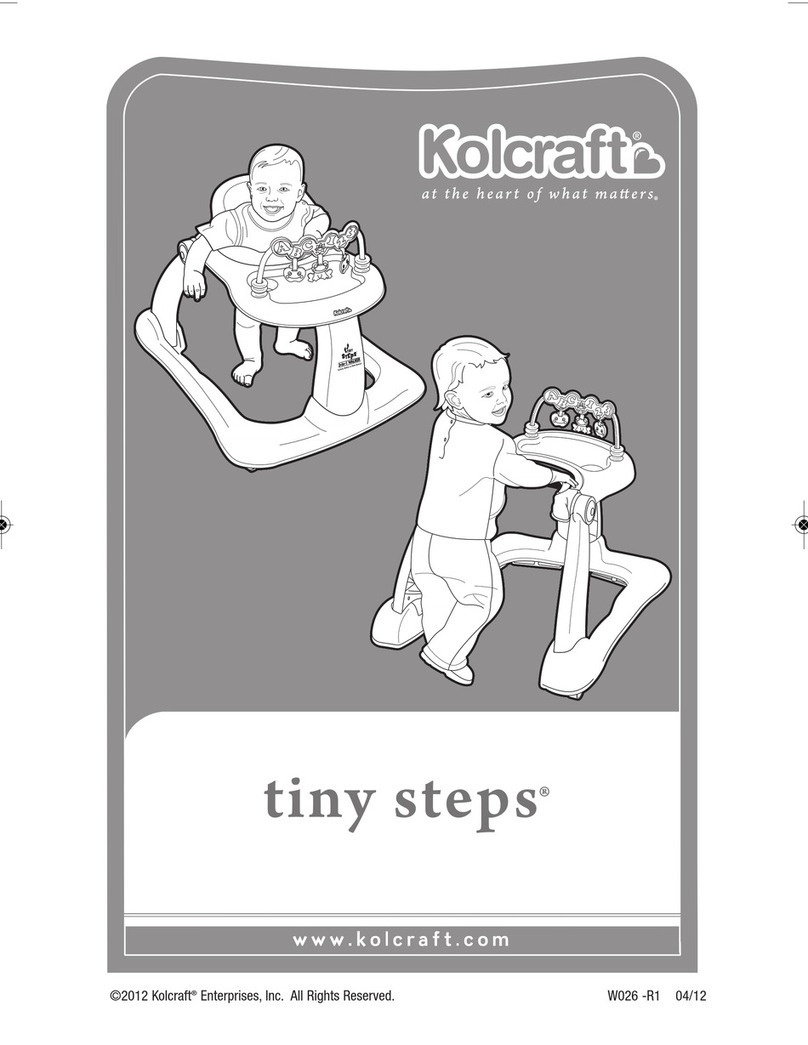
Kolcraft
Kolcraft tiny steps instruction sheet
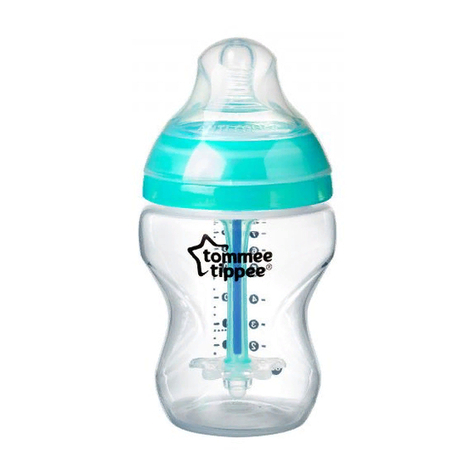
Tommee Tippee
Tommee Tippee Advanced Anti-Colic quick start
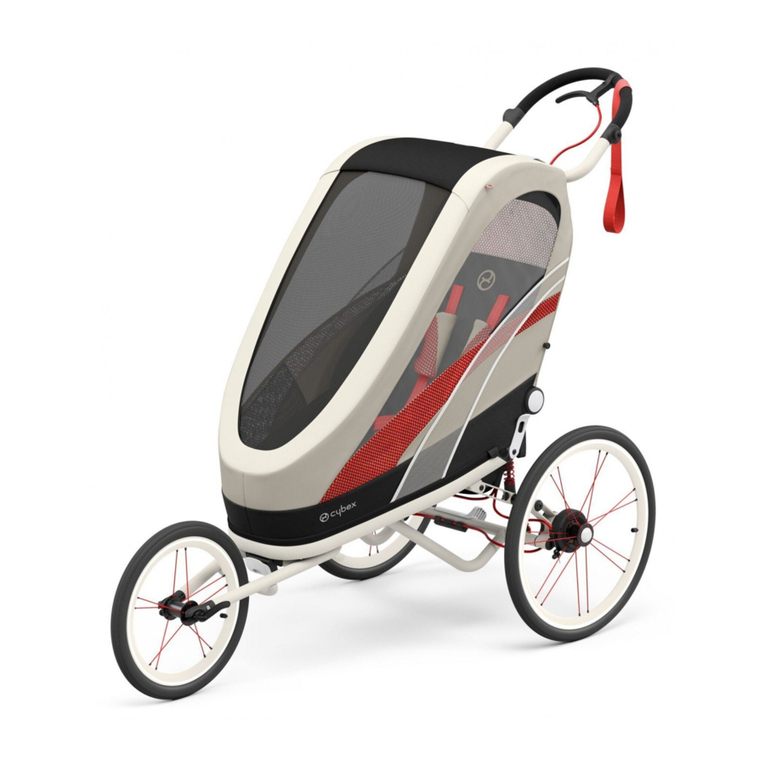
CYBEX gold
CYBEX gold ZENO manual

